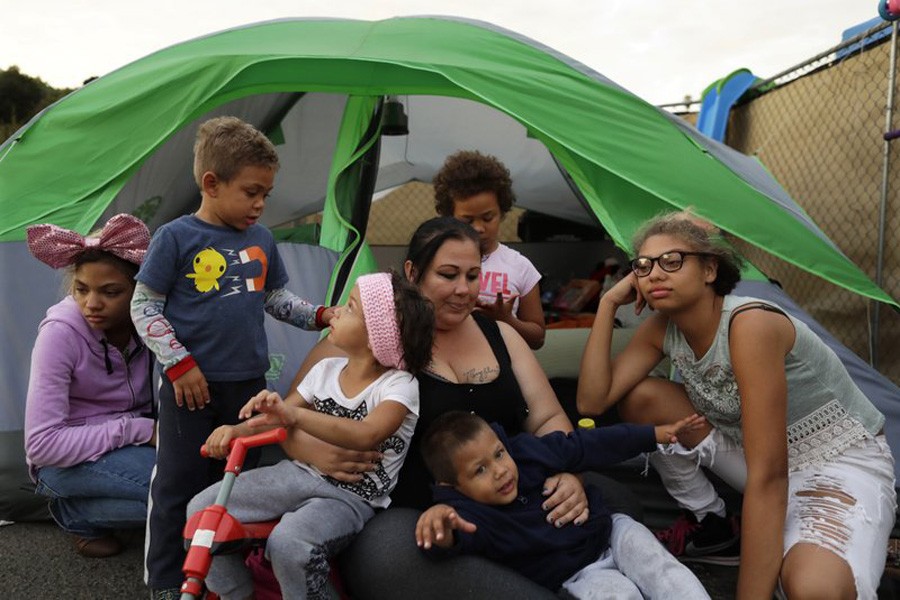
Published :
Updated :

Christine Wade found a haven in the tent she shared with six children, pitched in an asphalt parking lot.
It was, at least, far better than their previous home in the city, a shelter where rats ate through the family’s bags of clothes and chewed on 2-year-old Jaymason’s stroller. Roughly 50 of the encampment’s 200 residents were children, so Wade’s kids had plenty of playmates.
“It’s peaceful here,” Wade, 31, who is eight months pregnant, said in an October interview. “There’s coffee first thing in the morning. We can hang out here in the daytime. I mean what more could you ask for?”
A tent, of course, is not a home. But for these San Diegans, it is a blessing.
Like other major cities all along the West Coast, San Diego is struggling with a homeless crisis. In a place that bills itself as “America’s Finest City,” renowned for its sunny weather, surfing and fish tacos, spiraling real estate values have contributed to spiraling homelessness, leaving more than 3,200 people living on the streets or in their cars.
Most alarmingly, the explosive growth in the number of people living outdoors has contributed to a hepatitis A epidemic that has killed 20 people in the past year — the worst U.S. outbreak of its kind in 20 years. Deplorable sanitary conditions help spread the liver-damaging virus that lives in feces.
“Some of the most vulnerable are dying in the streets in one of the most desirable and livable regions in America,” a San Diego County grand jury wrote in its report in June — reiterating warnings it gave the city repeatedly over the past decade to better address homelessness.
San Diego has struggled to do that. Two years ago, Mayor Kevin Faulconer, a moderate Republican, closed a downtown tent shelter that operated for 29 years during winter months. He promised a “game changer” — a new, permanent facility with services to funnel people to housing.
But it wasn’t enough.
The result? Legions of Californians without shelter. A spreading contagion. Endless political disputes over what can and should be done — and mounting bills for taxpayers. Struggling schools and other institutions. And an extraordinary challenge to the city’s sunny identity that threatens its key tourism industry.
For now, San Diego again is turning to tents. The campground where the Wades lived was only temporary; this month, officials are opening three industrial-sized tents that will house a total of 700 people. There are plans afoot to build less-makeshift housing. But to deal with the immediate emergency and operate the giant tents, the city had to take $6.5 million that had been budgeted for permanent homes.
Democrat Councilman David Alvarez cast the only vote against the plan. “Had we actually invested in a homeless strategy, we would not be here today being asked to warehouse 700 people in giant tents,” he said.
Republican Councilwoman Lorie Zapf’s mother was mentally ill and died homeless in Los Angeles. She agreed with Alvarez that the tents were not a perfect solution to San Diego’s crisis, but she could not in good conscience pass up a chance to get people off the streets.
“We need to do anything we can to stop this tsunami of people who are ending up on our sidewalks,” she said.
“The people of San Diego need to decide what they want the city to look like,” said Gordon Walker, who took the helm this summer of the San Diego Regional Task Force on the Homeless amid praise for his efforts in combatting chronic homelessness in Utah.
“San Francisco has essentially given up its streets to the homeless,” added Walker, who served as deputy undersecretary for the U.S. Department of Housing and Urban Development during the Reagan administration. “It could go either way here. The real issue is we don’t have enough housing.”
Last year, the number of people living outdoors in San Diego jumped 18 percent over the previous year, according to an annual count taken in January. More than 400 makeshift shelters sprung up downtown, covering sidewalks across from new high-rise apartment buildings that have climbed in lockstep with the booming biotech-heavy economy and soaring rents, among the nation’s highest. A studio apartment goes for around $1,500 a month, on average, reports AP
Most of the homeless, like the Wade family, did not migrate to San Diego to live on the streets but are local residents who became homeless in a city where rents increased nearly 8 percent in a year. High-rise buildings have replaced discount residential buildings that offered single rooms for rent, housing people living paycheck-to-paycheck. Nearly half of the 9,000 rooms have disappeared since 2003.


 For all latest news, follow The Financial Express Google News channel.
For all latest news, follow The Financial Express Google News channel.